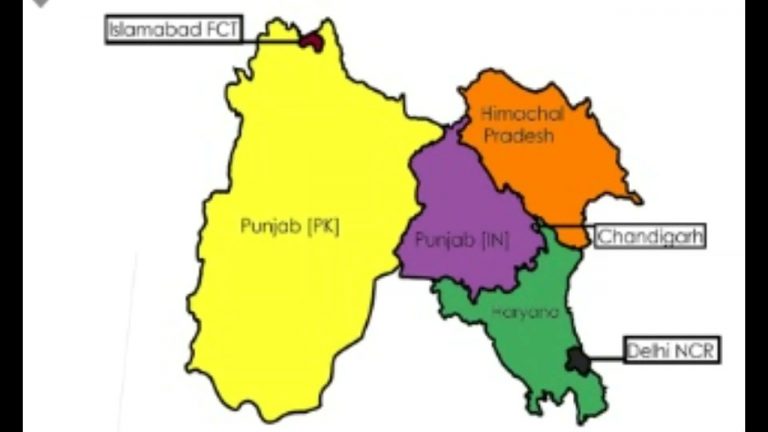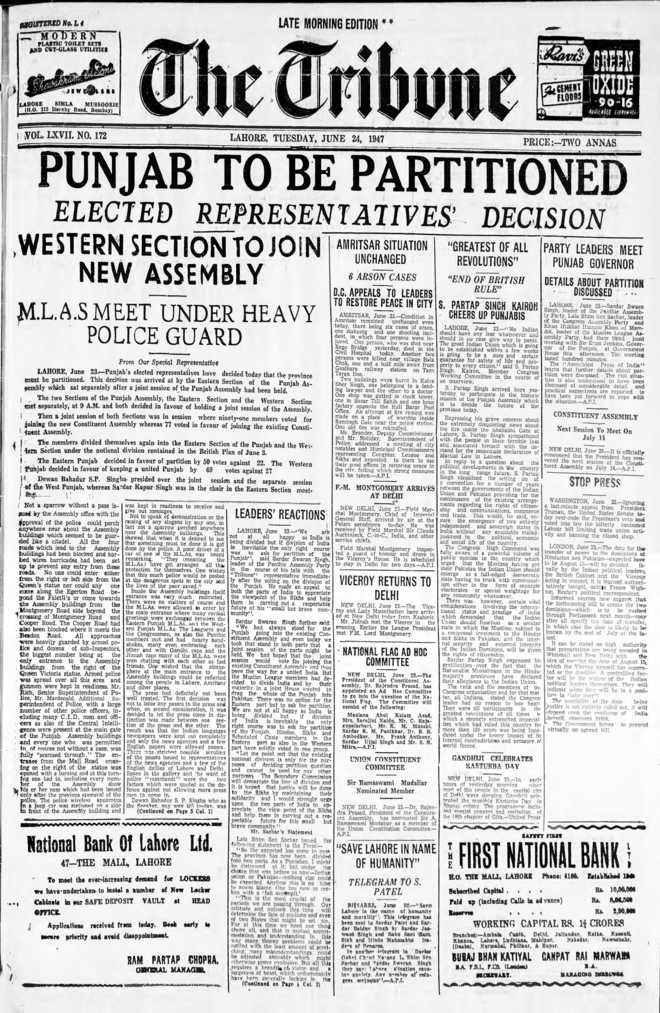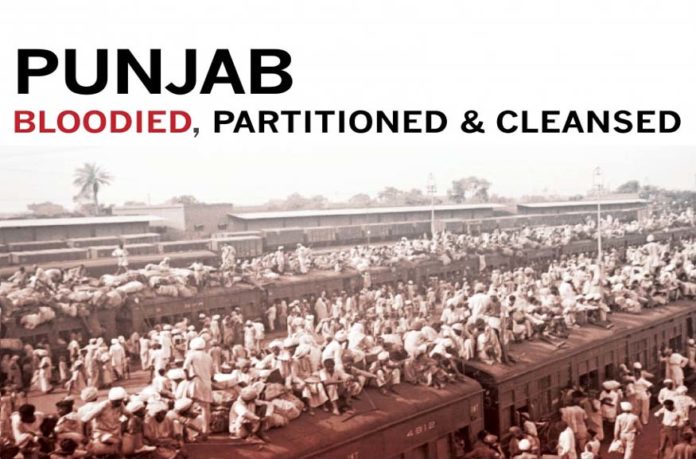
A look at events leading to and the aftermath of three different partitions of Punjab after the emergence of British rule
By Yadwinder Singh
In history of Punjab after emergence of British rule there had been three major partitions – In 1901 (formation of NWFP), in 1947 (division into east and west Punjab to join India and Pakistan respectively after independence) and in 1964 (division into Haryana and Himanchal Pradesh Union Territory region).
All partitions will be examined under three key areas: Events leading to partition; process of partition; aftermath; formation of British Punjab. According to Administrative Report 1849-51, the British Punjab was formed with following:- The Punjab Proper and Trans-Sutlej Territories Cis-Sutlej Territories. According to Administrative Report of 1868-69, the British Punjab was “bounded on the north and north-east by the Himalayas, on the east by river Yamuna, on the south by the district of Mathura in the North Western Provinces, the states of Rajputana and the river Sutlej and on the west by Suleiman Hill and Afghanistan.” In 1958 Delhi was made part of Punjab.
Formation of NWFP 1901 – events leading to partition: The Afridi tribe had received subsidy from British India for safeguarding the Khyber Pass for sixteen years. Suddenly, however the tribesmen rose and captured all the posts in the Khyber Pass held by their own countrymen. Battle of Saragarhi occurred at this stage while another outbreak by Mohmands (Pashtuns) in the hill country west of Peshawar. The main reason was said to be demarcation of Durand line as it divided tribes into and British India. Mullahs were also considered responsible for this uprising as they preached against British annexing their country. Aamir of Afghanistan was also said to be involved in arousing military sprit among local tribal. Two expeditions were sent by British army to settle the conflict: 1. Tirah Campaign (1897-98) 2. Mohmand Campaign (1897-98). Both expeditions were successful and conflicts were very much resolved.
 Process of Partition: In 1898 Lord Curzon became viceroy of India. His response to conflict between border area and the British was to change government structure of that area. Pashto speaking districts were separated from the Punjab province. New province was carved out of Punjab consisting districts- Hazare, Peshawar, Kohat and Trans-Indus Portion of Bannu and Dera Ismail Khan. The newly created province was called North Western Frontier Province. It is also said that NWFP was created as a buffer zone to protect India from attack of Russian empire.
Process of Partition: In 1898 Lord Curzon became viceroy of India. His response to conflict between border area and the British was to change government structure of that area. Pashto speaking districts were separated from the Punjab province. New province was carved out of Punjab consisting districts- Hazare, Peshawar, Kohat and Trans-Indus Portion of Bannu and Dera Ismail Khan. The newly created province was called North Western Frontier Province. It is also said that NWFP was created as a buffer zone to protect India from attack of Russian empire.
Aftermath: New province was to be managed directly from Calcutta. Lord Curzon placed them in the charge of Chief Commissioner responsible to Government of India. On 1st December 1931 NWFP was given the status of governor’s province and its chief commissioner. A legislative council was also set up with 40 members among which 22 were to be Muslims. In 1911 Delhi was separated from Punjab and made India’s capital.
Partition of 1947: The partition of Punjab was directly linked to the partition of India. It was the inevitable result of the developments that made their headway during the last hundred years. The Punjab before partition in 1947 comprised 29 districts each tehsil having 1000 to 2000 villages with 3 or 4 tehsils in the district. For administration tehsils were grouped into five divisions: 1. Ambala division- Gurgaon, Rohtak, Hisar, Ambala, Karnal. 2. The Jullundur division- Kangra, Jullundur, Ludhiana, Hoshiarpur, Firozpur. 3. The Lahore division- Amritsar, Sialkot, Lahore, Gurdaspura, Shekhupura, Gujranwala. 4. The Multan division- Lyallpur, Multan, Montgomery, Jhang, Dera Gazi Khan, Muzaffarabad. 5. The Rawalpindi division- Gujrat, Jhelum, Rawalpindi, Attok, Shahpur, Mianwali.
Events leading to partition: History of Indian Muslims under British rule: Muslim population was scattered throughout subcontinent. There were some main clusters of Muslim majority in north-east and north-west. There was ethnic division between Indian Muslim: 1. The Ashraf (direct descendants of the invaders, elites, landlords, Urdu language and minority) and 2. The Ajlaf (Coverts, majority, local language, peasants and labors) The Indian census started in 1881 formed the basis for the stereotypes of rigid religiously defined communities. Muslim elites in UP were afraid of Hindu domination. Hindi-Urdu controversy, anti-cow killing riots in 1893. In 1906 All India Muslim League was created at Decca in All-India Muhammadan Educational Conference. Its membership was just limited to just 400 out of which 70 were from up.
Its principle aim was to voice Muslim views during discussions concerning constitutional reforms from 1907 onwards. League’s demanded for separate electorates and reservation of seats within imperial legislative council. Both were accepted in: Indian Councils Act (1909) (Minto-Morley reforms). Separate electorates were designed to increase Muslim representation in the system of elected local government which was introduced from Indian Council Act 1861. Some writers say it was part of colonial divide and rule policy and was first step in the process of partition. Communal representation 1909 strengthened the belief that people following certain religions, naturally shared common interest from which other were excluded. The principle of communal representation was pushed further in the Government of India Act, 1919. Montague-Chelmsford Reforms: This award accorded separate electorates for Muslims, Europeans, Sikhs, Indian Christians, Anglo Indians, and even Marathas in there minority provinces.
Pre-partition decade: Chaudhary Rehmat Ali had in 1933 coined the term “Pakistan” “the land of pure” which would consist of Punjab, Afghan (NWFP), Kashmir, Sindh and Baluchistan. The pamphlet in which appeared “Now or Never” was largely ignored at that time. In August 1933, Muslim delegation to the parliament committee of India dismissed Pakistan as “chimerical and impracticable”. Two major developments transformed the demand into practical politics: 1. the experience of congress rule in Muslim minority area following the introduction of provincial autonomy in 1935. 2. The second was the impact of Second World War. The Government of India Act (1935) introduced a substantial measure of representative government through provincial autonomy. ‘Law and Order’ subjects which were previously been kept under British control in the system known as ‘Dyarchy’ were now handed over to elected Indian representatives. In elections of 1937 Muslim league achieved its best result in the Muslim minority areas where it portrayed itself as guardian of Muslim interests in up 29 out of 64 Muslim seats. In Punjab, Unionist Party formed the government while the Congress formed the government in 7 out of 11 provinces. Congress appeal to Muslim voters was very limited they contested only on 58 Muslim reserved seats out of 482 and won only26. Cow Protection Act and use of Hindi showed image of future congress. Muslim league leaders had created a fear of Hindu domination among Muslim populace. In October 1939 congress resigned as viceroy Linlithgow had declared war on behalf of India against Germany. On 22 Dec 1939 Muslim league celebrated deliverance day (celebrated as end of ‘unjust’ congress rule). March 1940 in Lahore Jinnah gave two-nation theory for separate Muslim homeland. At time it was called Lahore resolution as Jinnah didn’t mention the name Pakistan in his speech but it was popularized as Pakistan resolution. Jinnah demanded Muslim majority areas in north-east and north-west to be carved out as separate nation for Muslims. Muslim League operated with state patronage, while congress devoted its energies to struggle against British rule. As Congress leaders were busy in or in jail due to participation in Non-Cooperation Movement (1939-42) or Quit India Movement (1942), Muslim league was free to popularize Pakistan demand.
On 18 Oct. 1939 Viceroy in his speech referred Congress as Hindu party while Muslim league as representing all Muslims of country. August offer (1940) made it clear that British would not transfer power to any system of government whose authority was ‘denied by large and powerful element in India’s national life’. • March 1942 Sir Stafford Cripps was sent to India to secure Indian support for war and offer future constitutional reforms. • Cripps Mission was also sent to demonstrate good faith to America who were now their war allies and anti-colonist. • 1945 Shimla Conference was called by Lord Wavell with intent to break the ice between congress and Muslim league. • Jinnah demanded that all Muslim members of Indian Executive Council should belong to Muslim league. • 1946 elections Muslim league gave blow to the Unionist by winning 75 out of 86 Muslim seats. • In center league won 439 out of 494 Muslim seats, leagues claim for representing all Muslims was vindicated. • NWFP was only province where Congress won more Muslim seats with their collation party Khudai Khidmatgars. • Yet in the June referendum population of province voted for the inclusion in Pakistan.
 Punjab Events: Separate representation for Muslims • In Punjab Muslims were in a majority (55%). • It was the only province where majority community had been granted separate representation. • Separate representation was justified due to their narrow majority and their economic backwardness. • Hindus and Sikhs dominate the fields of industry commerce trade and banking. • Non-Muslims dominated in the activities of agriculture and money lending. Muslim domination opposed • The Sikhs and Hindus opposed the representation and reservation of seats. • Hindus argued that there should be no reservation of majority community.
Punjab Events: Separate representation for Muslims • In Punjab Muslims were in a majority (55%). • It was the only province where majority community had been granted separate representation. • Separate representation was justified due to their narrow majority and their economic backwardness. • Hindus and Sikhs dominate the fields of industry commerce trade and banking. • Non-Muslims dominated in the activities of agriculture and money lending. Muslim domination opposed • The Sikhs and Hindus opposed the representation and reservation of seats. • Hindus argued that there should be no reservation of majority community.
Proposals for the partition of Punjab • In order to solve communal tangle in Punjab, Sir Geoffrey Corbett suggested the separation of Ambala division from the Punjab. • He argued “historically, Ambala division is part of Hindustan and its inclusion in the province of the Punjab was an accident of British rule. Its language is Hindustani, and its people are skin to adjoining Meerath and Agra divisions” • This would have increased Muslim majority to 63% in the state. • In order to counteract sir Geoffrey’s scheme Sikh delegation suggested a territorial rearrangement which would take from Punjab the Rawalpindi and the Multan division(excluding Montgomery an Lyallpur districts). • This division would have raised Hindu and Sikh to majority in the remaining state. • Lahore resolution of Muslim league demanded creation of Muslim state to consist of “geographically contiguous units, demarcated into regions with such a territorial readjustment a may be necessary” • “territorial readjustment” involved obviously splitting up of Punjab. • The whole Punjab could not apparently be include in Pakistan as it areas with Hindu majority.
________________________
Courtesy: Slide Share